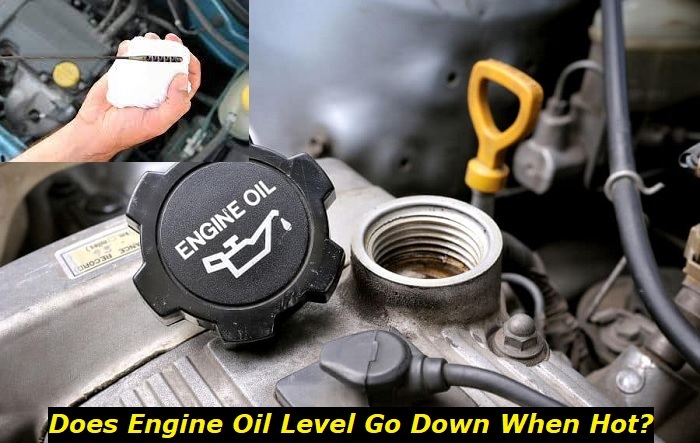The simple answer to this query is "no." Instead, when oil is exposed to high temperatures, it expands just like other liquids do, and the level slightly rises. However, engine oil does have a limited ability to expand when hot and its level does somewhat rise but not significantly.
Oil leaks highlights
- Level of urgency:medium
- Average mileage:over 50,000 miles
- Repair cost:$200 - $1,800
- DIY repair:only in some cases
- Commonreasons:head gasket, other gaskets, seals, fasteners
- If ignored:low engine oil level, contamination of units under the hood, engine damage
- How to solve:locate the leak and repair the system that is leaking

Does Oil Level Go Down When Hot?
No. The engine oil does not go down when hot. Oil molecules have weaker molecular bonds than solids. This causes them to melt more quickly and thinly when subjected to heat. The level of oil goes up with how much lighter they become.
So, the oil level does go up when hot, however, there isn't much of a difference. Because of this, there has been a consensus that oil levels should be checked when the engine is cold.
When the oil is cold, it's easy to determine the exact level and prevent burns that a hot engine can cause. However, if the oil is heated, it slightly goes up and hence gives a false oil level reading.
Despite this, some car owners still advise checking the oil level when it is hot though. In either case, should you check your car's oil in hot or cold conditions? This varies with the type of car you have.
Even though checking the Castrol Oil level when warm may be ideal especially when in cold weather, checking the Castrol Oil level when cold will give you a more accurate reading since it is in this condition that it is in its natural state.
This is true since freezing oil contracts hence reducing its level, therefore likely to produce an inaccurate reading.
Additionally, if the oil is topped off to the maximum level in this situation, it may overflow the maximum line as the engine heats up and spills out into the oil pan.
So, Why Does Oil Level Go Up Rather Than Down When Hot?
Engine oil level does go up as it gets hot, as was already mentioned earlier. But what causes the hot engine oil level to go up? We all know that molecules do exist in liquids and oil isn't an exception.
As a result, oil fills up more space between these molecules when it is subjected to extreme heat. The oil level then goes up because its molecular connections become weak and will constantly give way to heat.
Theoretically, the kinetic energy-driven thermal expansion is what is always responsible for this rise in oil level when hot. The level of a liquid rises when subjected to heat owing to thermal expansion, whereas kinetic energy is the energy produced by motion.
So let's decipher how heat causes the engine oil level to go up due to thermal expansion and kinetic energy.
The engine in your car always warms up as you keep driving. As this happens, the oil in the oil pan continuously flows to all other moving engine parts that require lubrication. This is after the oil has passed through the oil filter.
However, as the components keep moving, they heat up and invariably make the engine oil hot. The overheated engine may even occasionally produce extra smoke which can be detected coming from the engine bay.
Additionally, the kinetic energy produced by these engine moving parts is transformed into heat energy, which raises the engine's temperature.
The oil then flows easily as a result of this movement and rise in temperature. As a result, the engine oil level goes up because of the kinetic energy space created between its molecules.
So, When Should You Check Your Oil Level: When Hot or Cold?
It's recommended to check the engine oil levels when it's cold for the majority of cars. However, you may wait for at least 15 minutes after the engine is turned off if you wish to check the oil level when it's warm. That is roughly how long it takes for the oil to completely pour into the pan.
You have to wait until oil temperatures have returned to normal for maximum safety. This is because of how easily the oil temperature can rise to 250 degrees Fahrenheit. It's extremely risky to check the oil level at such a temperature.
However, modern vehicles equipped with electronic oil level controllers can only gauge the oil accurately while it is warm. Additionally, the car needs to be parked on a level, flat surface before checking the oil level.
Because of this, car manufacturers today often advise drivers to check the engine oil level while the engine is still warm. This tends to produce a more precise outcome. A caution though, simply avoid reading the engine oil level when it's hot!
In my opinion, what is significant when checking the oil level is to allow enough time (approximately 15 minutes after the engine is shut) for the oil to return to the oil pan after the car has been driven rather than checking the oil level when hot or cold.
This is because, for you to find an accurate reading on the oil level, it must first be allowed to return to the oil pan.
Does the Type of Oil Impact How It Goes Up When Hot?
Yes. Depending on the engine temperature, different types of oil can go up when hot or go down when cold at different rates.
For instance, synthetic oil expands and contracts with temperature changes at the fastest rate. This means that synthetic oil will expand greatly when hot and contract more when cold.
Under any temperature conditions, the expansion and contraction of standard conventional oil typically stay the same. This implies that whether hot or cold, conventional oil should generally show a similar reading.
Concerning the kind of oil you use, the level must be between the dipstick's recommended lines. Make sure you use the same kind of oil that is already in the engine if you have to top it off. Avoid the temptation of combining different types of oils, such as synthetic and traditional not unless it is necessary
How Can You Accurately Check Your Oil Level?
One of the easiest and sure ways to keep your oil at the proper level for optimal performance is to check the levels. This will guarantee that all engine components will receive the appropriate amount of oil necessary for optimal performance.
Fortunately, you don't need to be very knowledgeable to carry out this simple task. However, we advise you to read your car's owner's manual first to determine if any manufacturer guidelines need to be followed. Beyond that, here's a quick technique to check the oil level on your car.
- Take your car for a little drive if it is a more recent model. This should take no longer than ten minutes and all you need is to start the system's oil circulating. However, older cars do not need this spin. Once the oil is cold, you can pick up the instructions at step 3 for your older car.
- Give the car a 15-minute rest to let the oil cool down until it is only warm. If you only need to make a short drive, this process shouldn't take more than 15 minutes. Make sure you turn off the vehicle before checking the oil.
- Park the car on level ground to measure the oil level accurately. An uneven surface will give you false oil level reading.
- Look for the oil dipstick in the engine bay. It typically comprises a circular handle marked in orange or yellow.
- Take out the oil dipstick from its tube and clean it up with a clean cloth, then insert it back into its tube after cleaning it.
- Take out the dipstick once more after it has been reinserted into its tube. Check the oil level by looking at the oil dipstick's maximum and minimum marks. Your oil level should be situated somewhere in the middle of the maximum and minimum marks on the dipstick.
For an appropriate oil level, it should be as close to the maximum mark on the dipstick as possible. If the oil level is too low (somewhere far below the dipstick's maximum mark), be prepared to top it off immediately.
It's recommended to always change the engine oil filter at the same time as the oil to experience the greatest results.
Conclusion
''Does oil level go down when hot?'' This question has been effectively addressed in this article. The answer to this is ''No.'' Oil level does not go down when hot but instead, it goes up/expands due to oil's weak molecular connections, which are easily broken by heat.
Consequently, the oil level will eventually rise a little because of this. Checking engine oil levels requires caution to prevent erroneous readings.
Checking your oil level when the oil is cold can give you wonderful outcomes. To prevent burns, always check the level when the oil is cold, especially if you don't have much experience with auto-related maintenance. On the other hand, you can also check your oil level when the oil is warm.
Therefore, why is it crucial to check the oil level when the oil is warm? Checking the oil level when the oil is warm will give a better outcome, particularly if the weather is extremely cold. However, you should always keep in mind that a warm engine differs greatly from an excessively hot engine!
About the authors
The CarAraC research team is composed of seasoned auto mechanics and automotive industry professionals, including individuals with advanced degrees and certifications in their field. Our team members boast prestigious credentials, reflecting their extensive knowledge and skills. These qualifications include: IMI: Institute of the Motor Industry, ASE-Certified Master Automobile Technicians; Coventry University, Graduate of MA in Automotive Journalism; Politecnico di Torino, Italy, MS Automotive Engineering; Ss. Cyril and Methodius University in Skopje, Mechanical University in Skopje; TOC Automotive College; DHA Suffa University, Department of Mechanical Engineering






Add comment